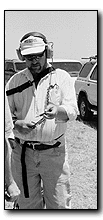![[ NEWS ]](/images/fall97/newsf97.gif)
Arizona Summer Wildcat June 17, 1998
Scouring for space stones
![[Picture]](04_1_i.gif)
|
Tanith L. Balaban
Search leader David Kring shows reporters samples of meteorites salvaged from other crash sites. The team did not find any meteorite fragments on Monday and Kring said the meteor may have disintegrated in Earth's atmosphere.
|
Arizona Summer Wildcat
The hunt for a $10,000 piece of shiny black rock continues 10 days after a meteor blazed through the Arizona sky.
A team of University of Arizona scientist and volunteers scoured the desert southwest of Casa Grande Monday for a possible crash site, but many said finding fragments was a long shot.
"The chances of us running across it today are pretty slim," meteorite search director David Kring said as the hunt kicked off. "Maybe we'll get lucky."
But fortune was not to be found in the central Arizona desert Monday, as the UA team found no fragments of the space rock.
"The task of finding any meteorites from this is large and will probably require some patience," Kring said.
Kring and his team have some competition, though, as local meteorite collector Robert Haag has offered $10,000 for a meteorite fragment weighing 2.2 pounds or more and half that price for a smaller chunk.
"I've got the money, honey, if you've got the pieces," Haag said yesterday. "There are no laws - It's finders, keepers."
One 6-year-old boy tagged along with his dad, John Blennert, who has found about 150 pounds of meteorites in the past with a metal detector . The boy, however, wasn't planning on giving the rock to Haag for the reward.
"I'll give it to my dad's friend," he said. "I have a meteorite at home."
Nobody brought the rock home Monday, possibly because the size and location of fragments remains uncertain.
Kring has not ruled out the possibility that the entire meteor disintegrated as it collided with the earth's atmosphere traveling between 25,000 and 50,000 mph.
"I have no idea if we will find anything at all," Kring said. "We could find a marble size fragment or a football size fragment - it's impossible to predict."
Kring added that the meteor could have come down anywhere in a little more than 100-square-mile area. Monday's team effort examined about two square miles with a couple dozen eyeballs and a handful of metal detectors.

Tanith L. Balaban/Arizona Summer Wildcat
John Blennert checks his metal detector on Monday before searching for fragments of a meteor that might have landed in the Casa Grande area 10 days ago.
The team relied on hundreds of eyewitness accounts from all over Arizona before finally choosing the site just off Interstate 8.
Kring said he realized some eyewitnesses contested the site.
"People as far north as Casa Grande and as far south as Rio Rico said they were sure it landed just on the other side of the street from them," Kring said.
The volunteers and scientists were not discouraged by returning home rockless.
"I'm not disappointed," said Dan Durda, a University of Arizona planetary lab research associate. "That's really what I expected."
He, along with the rest of the team and a handful of journalists, roughed 103 degree desert heat with a metal detector Monday and said he had plenty of false alarms.
Deceptive rocks shimmered and aluminum cans set off metal detectors, but Durda wasn't frustrated.
"There were a couple of times when I thought I'd found something," he said. "There was the adrenaline rush and you stop breathing, but then it would turn out to be a piece of tin can or a shell casing."
Durda and Kring plan to search farther west of the original site, but said local residents would probably find the fragments first - if they exist.
"It is likely the people who live and work in Casa Grande will find the meteorites, now that they are aware that these objects may have fallen in their area," Kring said.



